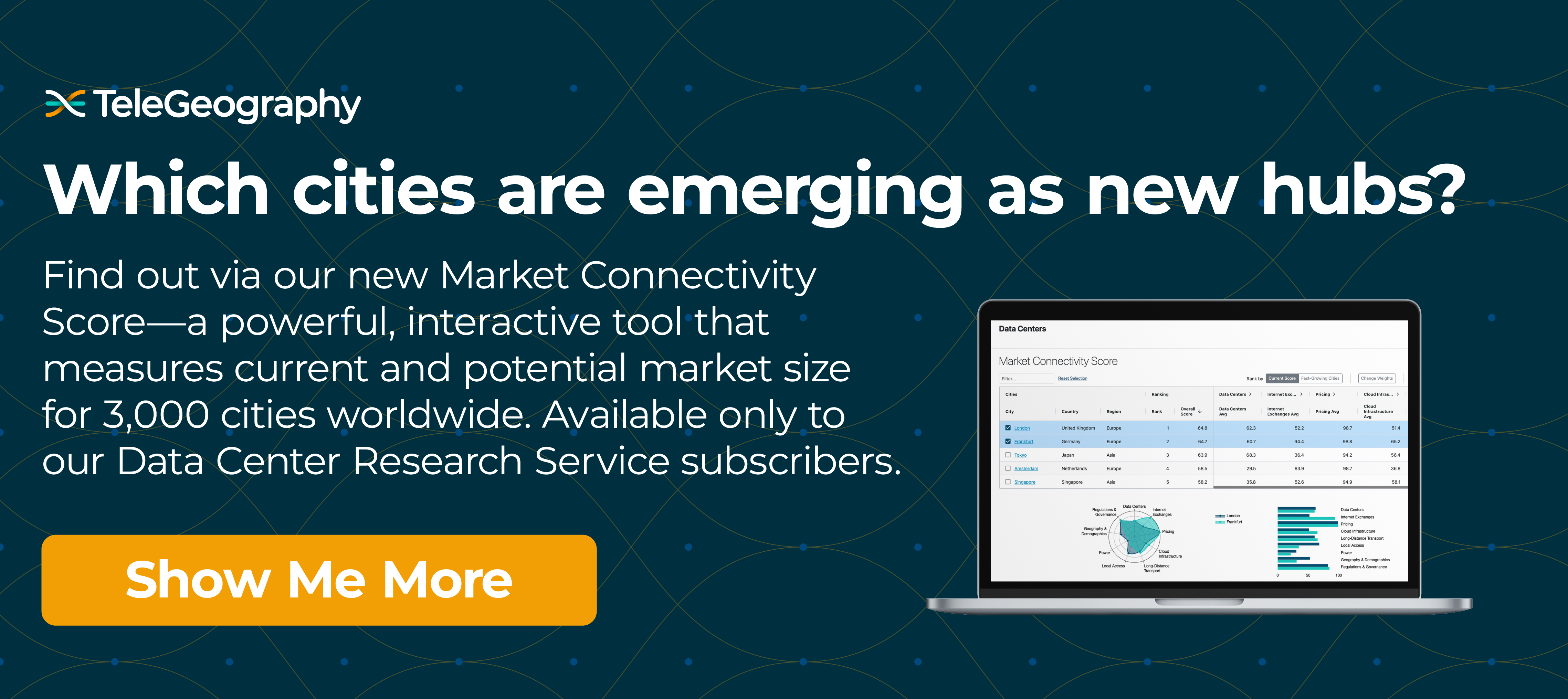A simple broadband connection to the internet remains one of the most common ways to access cloud networks and services. But as these services and architectures evolve, so do the ways companies can connect.
Today we're sharing our guide to connecting to cloud services from our Cloud and WAN Research Service. (For more on cloud service providers and related geography, jump over to our interactive Cloud Infrastructure Map.)
Internet
What is it? This is a basic internet connection to a public cloud service provider (CSP).
Who provides the service? You won't be surprised to learn that your internet service provider is the one to provide this service.
When is this used? When standard internet connection is “good enough” to access cloud services.
Why use this?
- Pro: easiest way to connect to the public cloud. No additional network costs to connect to the cloud through existing internet access through enterprise’s ISP.
- Con: higher data transfer prices than a dedicated interconnection. Shared network so higher chance of performance problems than through a private connection.
Dedicated Interconnect
What is it? This is a high bandwidth private link connecting an enterprise network directly to the CSP network, thereby bypassing public internet. This is usually offered at 1 Gbps or 10 Gbps and provides multiple VLAN connections over single interconnection.
Who provides the service? This one would be offered by a CSP.
When is this used? There are several use cases here:
- Used when enterprises require high capacity connections with high volume data transfer for storage, such as during a cloud migration.
- Used when enterprises require a hybrid cloud network architecture, connecting the on-premise data center with the cloud data centers.
- Used for lower latency, more predictable connection for better application performance.
- Used for more secure movement of sensitive data to and from the cloud data centers, thereby avoiding exposure to the public internet.
Why use this?
- Pro: compared to internet, allows for higher throughput, lower latency, better performance, and a more secure connection.
- Pro: lower data transfer prices than via public internet.
- Pro: allows multiple connections to both public and private (hybrid) environments over single interconnect.
- Con: higher cost than VPN or peering connections.
Partner Dedicated Interconnection
What is it? This is actually the same as a CSP interconnection, except partners offer service at smaller, sub-10 Gbps increments. It's offered from 50 Mbps to 10 Gbps.
Who provides the service? This is offered by CSP partner network service providers (NSPs).
When is this used? When enterprises have an existing carrier or colocation provider partnership. Or when enterprises require dedicated links in smaller increments.
Why use this?
- Pro: same latency, performance, and security benefits as dedicated interconnect.
- Pro: not limited to CSP on-ramps. Can reach the cloud on-ramps via the NSP’s network.
- Pro: lower data transfer prices than via public internet.
- Con: less cost effective at smaller capacity increments.
Cloud Exchange
What is it? This is a connection to multiple CSPs through a single connection to a provider's exchange switch. Offered from 50 Mbps to 10 Gbps increments.
Who provides the service? It's offered by colocation providers or internet exchanges.
When is this used? When enterprises have access to multiple clouds from a single connection in a single location. Or when enterprises have lower traffic and require lower capacities compared to dedicated one-to-one interconnect.
Why use this?
- Pro: single connection to multiple CSPs.
- Pro: lower data transfer prices than via public internet.
- Con: less cost effective at smaller capacity increments.
VPN Connection
What is it? IPSec VPN Tunnel connecting an enterprise network to the CSP network across the public internet.
Who provides the service? When enterprises have an existing NSP partnership.
When is this used? When enterprises don't require a high capacity data connection.
Why use this?
- Pro: lower cost than dedicated connection.
- Con: higher data transfer prices than via a dedicated connection.
- Con: higher possibility of issues with performance.
Direct Peering
What is it? Simply put, this is a direct peering connection between an enterprise and CSP network. The enterprise must have an ASN and meet CSP peering requirements.
Who provides the service? The CSP
When is this used? This is used with existing peering connections.
Why use this?
- Pro: no set up or maintenance costs and discounted egress data transfer rates compared to internet.
- Con: unlike dedicated interconnect, this connection is not part of the virtual private cloud (VPC) network, so routing management is more burdensome and complicated.
- Con: higher egress rates for data transfer compared with dedicated interconnection.
Carrier Peering
What is it? Same as direct peering except connects to CSP via an NSP, when an enterprise does not have its own ASN.
Who provides the service? Offered by NSP.
When is this used? Used with existing peering connections.
Why use this?
- Pro: in addition to the same benefits as direct peering, enterprise does not have to be located in a CSP peering location. Connects via NSP network.
- Con: usually higher cost peering via a NSP than directly with the CSP.
Patrick Christian
Patrick Christian is a Senior Research Manager with TeleGeography. He heads the Cloud and WAN Research Service. He also focuses on African and European markets specializing in international bandwidth markets and internet infrastructure, WAN services, terrestrial and submarine cable systems, and international voice traffic analysis.





